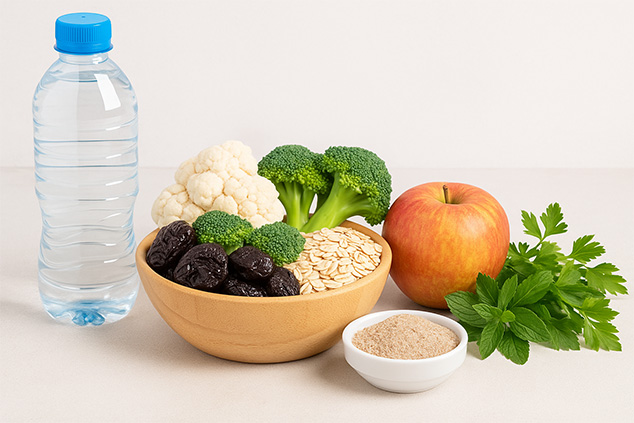A common topic in the kratom community is poop. Or, well, the lack thereof, to be more precise. Kratom constipation is a common occurrence and one of the side effects of taking kratom.
Does Kratom Cause Constipation?
Kratom can cause constipation, especially if you’re not drinking plenty of water or having a healthy balanced diet. The good news, however, is that constipation in itself is not a disease but simply a symptom.
Keep in mind though that some medical conditions can cause chronic constipation. So, if you are unable to get kratom constipation relief or you are constipated even if you’re not taking kratom, seeing your doctor for a checkup may be a good idea.
How Does Kratom Cause Constipation?
Kratom constipation occurs because kratom powder is ground up leaf matter, and as any edible part of a plant, it consists of fiber, primarily indigestible fiber. Too much insoluble fiber can cause constipation.
Let’s take a look at why we need fiber in our diet to understand this better.
Fiber, also known as dietary fiber, is an indigestible plant nutrient and a type of carbohydrate that you can find in all plants. Sometimes, it’s also referred to as roughage or bulk.
Our bodies cannot completely digest fiber. So, it travels down our digestive tract as it absorbs water on the way. This helps our bodies absorb nutrients, create the bulk of stool, and pass it easier and faster.
Though not all fiber is the same. Instead, there are two kinds:
- Soluble fiber: It absorbs water creating a thick paste. It helps slow down digestion which allows our bodies to absorb more nutrients
- Insoluble fiber: It does not absorb water, but forms the bulk of stool, which helps our bodies to comfortably eliminate waste.
For optimal digestion, we need to consume both and too much (or too little) of either one of these can disrupt digestion.
Too much soluble fiber can result in gas, bloating, and diarrhea. On the other hand, too much insoluble fiber can create a solid bulk of stool that’s hard to pass, resulting in constipation.
Why Is Constipation Bad?
Constipation, kratom constipation including, is not life-threatening. However, if untreated, it can cause problems, and complications if left untreated. Most common ones include:
Hemorrhoids: if you push when you’re trying to go, this can cause the veins around your anus to swell. Basically, these are like varicose veins around your anus. They can be painful, bleeding, and itchy. In severe cases, they can result in infections and blood clots.
Anal fissures: Passing stool that’s hard, can cause the tissue around your anus tear making going to the bathroom even worse. Serious tears can affect the ring muscle that keeps your anus closed and may even require surgery.
Impaction: If stool remains in your intestines, hard parts may stick together, causing a blockage. Over time, it can become too big to move and may require an ER visit.
Rectal prolapse: If you continuously push and strain when trying to go, it can cause a part of or the whole rectum to slip out. This can be very painful and cause bleeding.
Kratom is not working: Moreover, you may experience that kratom effects are no longer there. This can occur if you have a lack of soluble fiber in your diet, and your body is unable to properly absorb nutrients including alkaloids from the stool.
Now that you know you shouldn’t be holding that in, let’s look at ways to get you pooping.
Tips to Get Kratom Constipation Relief
1. Drink More Liquids
Drinking more liquids can soften your stool and make it easier to pass. On a regular basis, this can prevent kratom constipation from occurring in the future.
Aim for eight eight-ounce glasses every day. However, add an extra glass for every cup of coffee and approximately 30 minutes of exercise. Make sure to drink water. Fresh juices are beautiful to add, but in moderation, as they tend to have high amounts of sugar. Stay away from soda.
2. Increase Your Soluble Fiber Intake
Balance the insoluble fiber in kratom with foods that are rich in soluble fiber. Some examples include:
- Fruits such as apples, strawberries, oranges
- Vegetables such as broccoli, Brussels sprouts, and cauliflower
- Oatmeal and oat bran
- Lentils, beans, and peas
- Barley
- Chia seeds
- Flaxseeds (make sure they are ground up, or your body won’t absorb them)
- Wild rice
Make sure not to overdo soluble fiber though and not to load up on insoluble fiber instead. Too much of any fiber can lead to other issues such as diarrhea or worsen constipation.
3. Take Magnesium Supplements
Studies have linked magnesium supplements to reduced constipation. Therefore, kratom and magnesium taken together can result in easier stools. However, rely on it as a short-term solution only and look for the underlying factor behind your kratom constipation.

4. Add Probiotics
Probiotics contain live bacteria that help our bodies balance gut flora and absorb nutrients. They can help alleviate a number of digestive issues, including kratom constipation.
We currently have a limited understanding of the gut flora, though evidence points that a healthier gut can result in improvement of a variety of conditions such as depression, and anxiety and ADHD.
You can choose a probiotic supplement or add fermented foods to your diet. Some options include:
- Yogurt
- Kefir
- Sauerkraut
- Kimchi
- Pickles
- Miso
- Tempeh
- Kombucha
It’s best to opt for organic versions of these for more benefits.
5. Adjust Your Kratom Dose
The kratom dose that you’re taking may be too large. Review how much kratom you’re taking and whether you’ve recently upped your dosage. It that is the case, you may be developing kratom tolerance. Instead of increasing your dose, try rotating strains or looking into a different vendor.
6. Try Different Kratom
The kratom that you’re using may not be potent or consistent. So, you may be dealing with weak alkaloids that are not delivering the desired results. If you’re simply increasing the dose, you’re still being exposed to the same alkaloid content. Thus, the risk of developing kratom tolerance increases.
If your kratom supply is inconsistent, try looking into other vendors and trying different kratom. Higher-quality kratom will require lower doses, and your body will need to process less insoluble fiber.
7. Try (But Don’t Rely On) Laxatives
If you are looking for immediate kratom constipation relief, you can opt for over-the-counter laxatives. Make sure only to use them sparingly and drink plenty of water while you do so.
Laxatives are like a band-aid on a more severe wound. They alleviate your discomfort, but won’t actually solve the problem. They can also severely dehydrate you.
8. Try a Squatty Potty
Did you know that the western toilet does not provide the most optimal pooping position? In fact, it actually obstructs the angle of the colon and makes it harder to eliminate waste. It’s more civilized, but not how our bodies were designed.
Instead, squatting is a much better position. So, elevating our feet and propping them up on a stool creates a better angle and makes pooping easier and faster.
9. Do Yoga or Exercise
Most people in the west have sedentary lifestyles, which can be a contributing factor to kratom constipation. Increasing your activity and exercise level can boost your metabolism. Studies confirm that. So, try light exercise or yoga.
Keep in mind that one of these won’t likely not solve the issue, and you may need to have a holistic approach to kratom constipation.
Has kratom constipation bothered you? What works best for you?



Leave a Reply